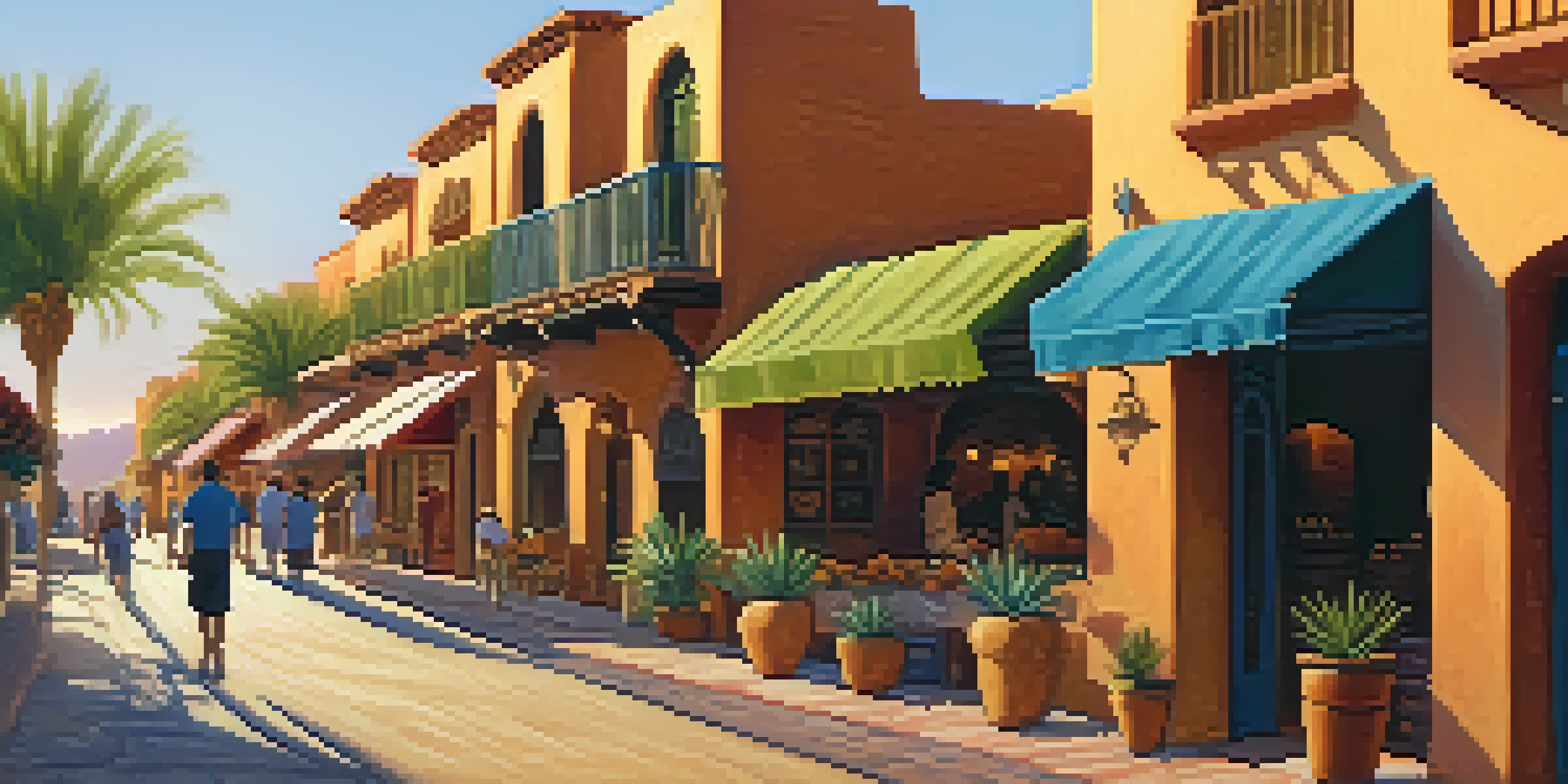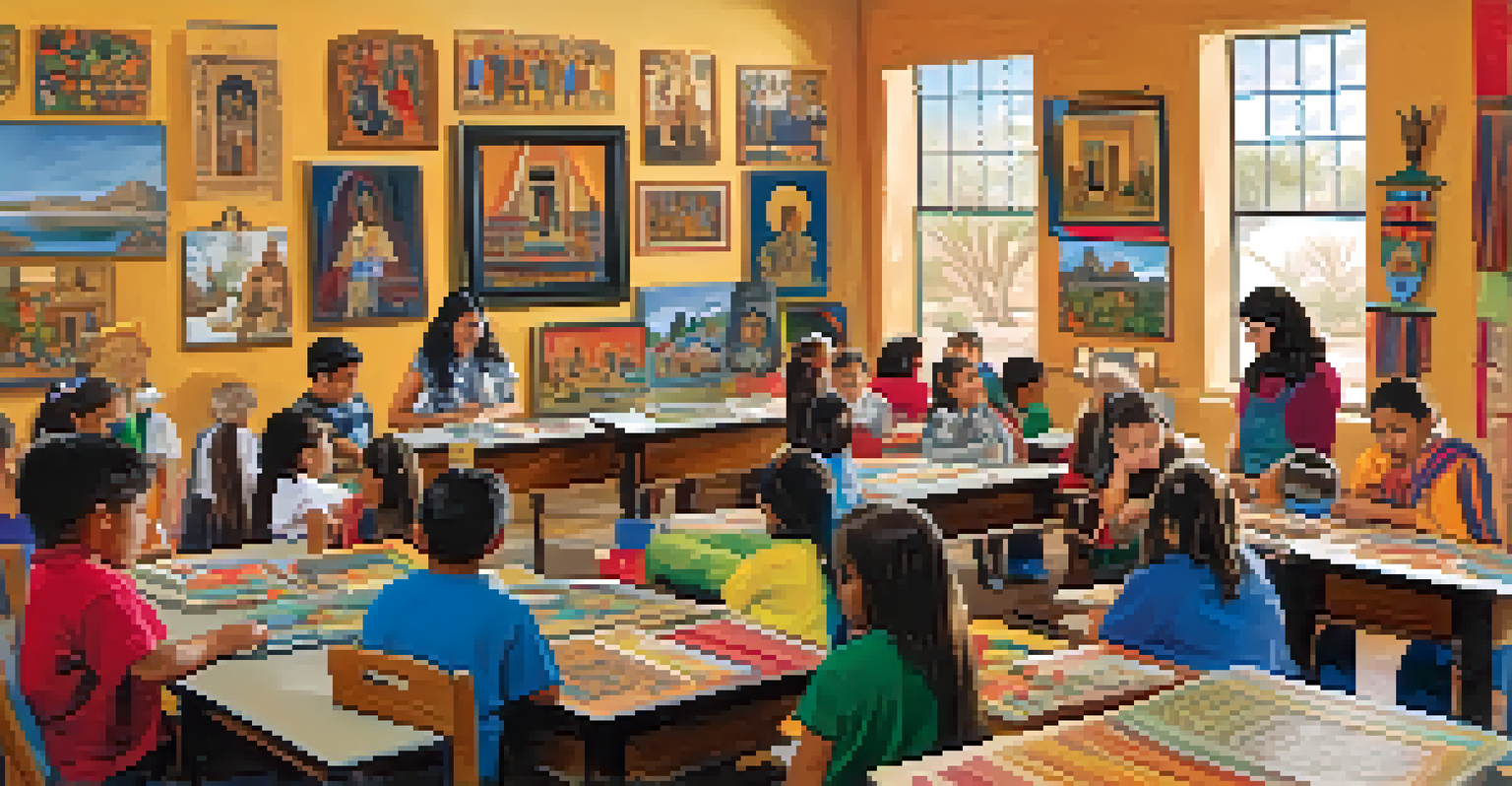Spanish Colonial Roots: Shaping Tucson's Cultural Landscape

Understanding Tucson's Spanish Colonial Beginnings
Tucson's roots can be traced back to the Spanish colonial period, which started in the late 17th century. Established as a fort and mission, Tucson became a pivotal site for Spanish expansion in the region. This early settlement laid the groundwork for what would evolve into a rich cultural tapestry.
A nation's culture resides in the hearts and in the soul of its people.
The influence of Spanish settlers is evident in the architecture and layout of the city. Many historical buildings reflect the Spanish style, characterized by adobe brick and tile roofs. Walking through Tucson's streets feels like stepping back in time, where the past continues to shape the present.
Additionally, the Spanish introduced agricultural practices that thrived in Tucson's arid climate. These innovations not only supported the community but also enhanced the local economy, proving that the colonial legacy is still alive and relevant today.
Cultural Fusion: The Intermingling of Traditions
Tucson's cultural landscape is a vibrant blend of Spanish, Indigenous, and later, American influences. This fusion has created a unique identity that is celebrated through festivals, food, and art. For instance, the annual Tucson Meet Yourself festival showcases this rich tapestry, featuring diverse cultural performances and cuisines.

Food plays a significant role in this cultural amalgamation, with dishes that highlight both Spanish and Indigenous ingredients. From tamales to tacos, the flavors reflect centuries of culinary evolution. Each bite tells a story of the people and their traditions, reminding us of the shared history.
Tucson's Rich Spanish Colonial Roots
Tucson's history is deeply influenced by its Spanish colonial beginnings, evident in its architecture, agriculture, and ongoing cultural practices.
Moreover, local artists often draw inspiration from this cultural mix, creating works that resonate with Tucson's heritage. Galleries and public art installations display pieces that highlight both the beauty and complexity of Tucson's cultural roots, inviting residents and visitors alike to appreciate this rich history.
The Role of Language in Cultural Identity
Language is a powerful aspect of Tucson's cultural identity, with Spanish being widely spoken alongside English. This bilingual environment reflects the city's historical roots and its ongoing connection to its Spanish heritage. It fosters a sense of community among residents who share these linguistic ties.
Culture is the widening of the mind and of the spirit.
In schools and community programs, bilingual education emphasizes the importance of both languages. This approach not only preserves the Spanish language but also enhances cultural understanding among diverse populations. By valuing both languages, Tucson builds bridges between generations and cultures.
Additionally, local media outlets often present content in both languages, further showcasing the importance of bilingualism in daily life. This commitment to language diversity enriches the community, ensuring that Tucson's Spanish colonial roots remain a living part of its cultural identity.
Architectural Heritage: A Testament to the Past
Tucson's architecture tells a story of its Spanish colonial past, with many buildings reflecting traditional designs. Structures like the San Xavier del Bac Mission stand as iconic examples of Spanish colonial architecture, showcasing intricate details and beautiful frescoes. These landmarks are not just tourist attractions; they are vital pieces of Tucson's history.
The preservation of these architectural gems is crucial for maintaining the city's identity. Efforts by local organizations and government initiatives aim to protect and restore historic sites, ensuring they can be appreciated by future generations. This commitment highlights the value placed on cultural heritage in Tucson.
Cultural Fusion Celebrated in Tucson
The city showcases a vibrant blend of Spanish, Indigenous, and American traditions through festivals, food, and art, fostering a unique cultural identity.
Furthermore, the blend of Spanish colonial architecture with modern styles creates a unique urban landscape. New developments often incorporate traditional elements, allowing the past to coexist with contemporary life. This architectural dialogue enriches Tucson's aesthetic and cultural depth.
Festivals: Celebrating Heritage and Community
Festivals in Tucson provide a vibrant platform to celebrate the city's rich cultural heritage. Events like the Tucson Festival of Books and All Souls Procession draw crowds from all walks of life, showcasing literature, art, and traditions that reflect the area’s Spanish roots. These gatherings foster a sense of community and pride.
During these celebrations, attendees can experience the flavors of Tucson through local cuisine, including traditional Spanish dishes. Food trucks and local vendors fill the streets, offering a taste of history that connects people to their heritage. Sharing meals becomes a communal experience that reinforces cultural bonds.
Additionally, live performances at these festivals often feature traditional music and dance, further immersing participants in Tucson's cultural tapestry. From mariachi bands to folk dances, these artistic expressions honor the city's diverse influences, creating a lively atmosphere filled with joy and connection.
Education: Passing Down Cultural Knowledge
Educational institutions in Tucson play a vital role in preserving and sharing the city’s Spanish colonial history. Schools often incorporate local history into their curricula, helping students understand the significance of their cultural roots. This education fosters pride in their heritage from an early age.
Programs that focus on cultural heritage encourage students to explore their identity and connect with their community. By participating in projects related to Tucson's history, children learn about the struggles and triumphs of those who came before them. Such initiatives create a sense of belonging and continuity.
Language and Education Preserve Heritage
Bilingualism and educational initiatives in Tucson help maintain its cultural heritage, ensuring that the community's Spanish roots are passed down through generations.
Moreover, community workshops and events often invite families to engage in traditional crafts and practices. This hands-on approach to learning not only keeps traditions alive but also strengthens family bonds. As families come together to explore their heritage, they contribute to the ongoing narrative of Tucson's cultural landscape.
The Future: Embracing a Diverse Cultural Legacy
As Tucson continues to grow, its cultural landscape remains a testament to its Spanish colonial roots. The city embraces its diverse heritage while welcoming new influences, creating a dynamic environment that reflects a range of experiences. This fusion of cultures enriches Tucson's identity and makes it a vibrant place to live.
Looking ahead, community efforts aim to enhance cultural understanding and appreciation among residents. Initiatives that celebrate diversity help bridge gaps between different groups, fostering unity and collaboration. Such endeavors ensure that Tucson remains a welcoming city for all.

Ultimately, Tucson's future lies in its ability to honor its past while adapting to new cultural narratives. As the city evolves, its Spanish colonial roots will continue to shape its character, reminding everyone of the rich history that binds the community together.